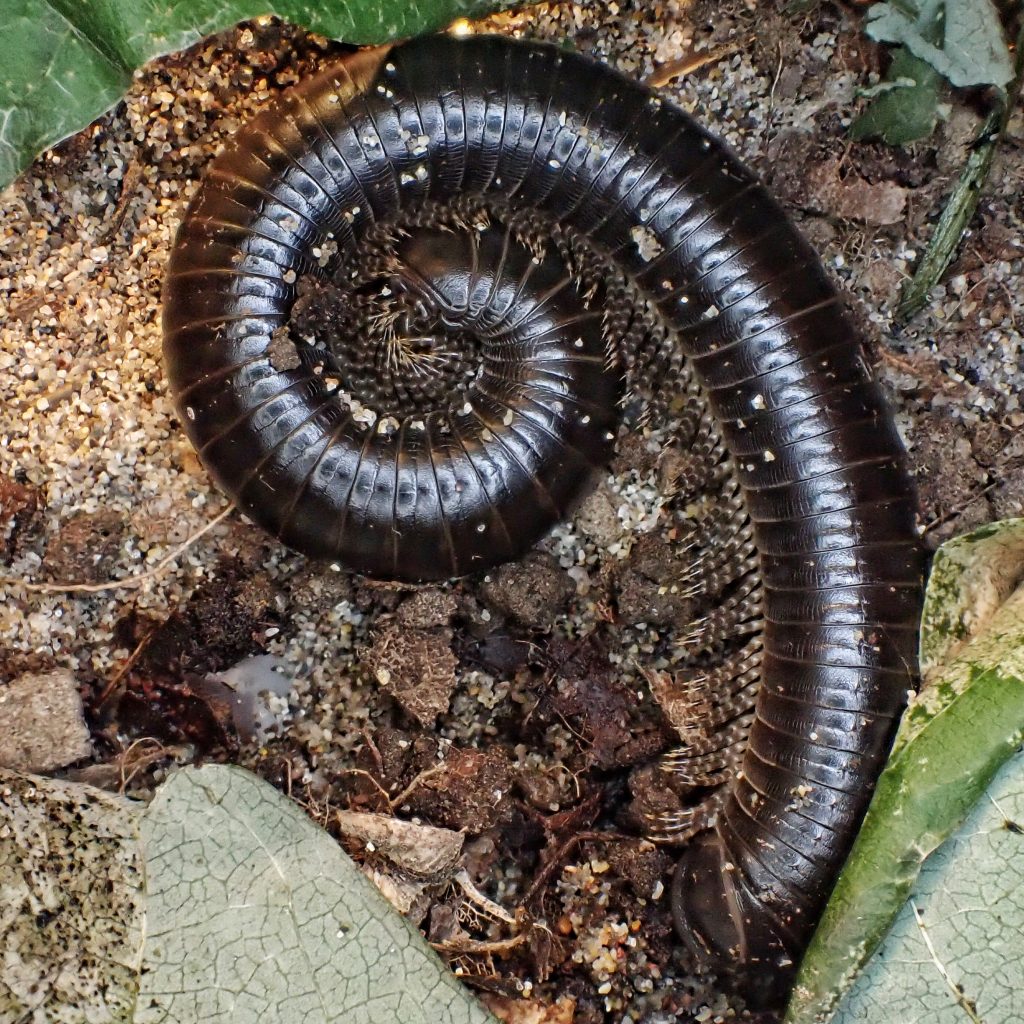
Millipedes are in the same subphylum, Myriapoda, as centipedes, but they belong to their own class, Diplopoda. Within this class are 16 orders, and 145 families, evidence of the amazing diversity of the millipedes of the world. Our adorable, gentle giant Tylobolus uncigerus is a member of the order Spirobolida, and the family Spirobolidae, and is the only member of its order in our region. Fossil evidence shows that millipedes have been around for at least 420 million years. Many thanks to William Shear and Sam McNally who reviewed the original post and pointed out my errors, and I have now edited this profile to correct them.
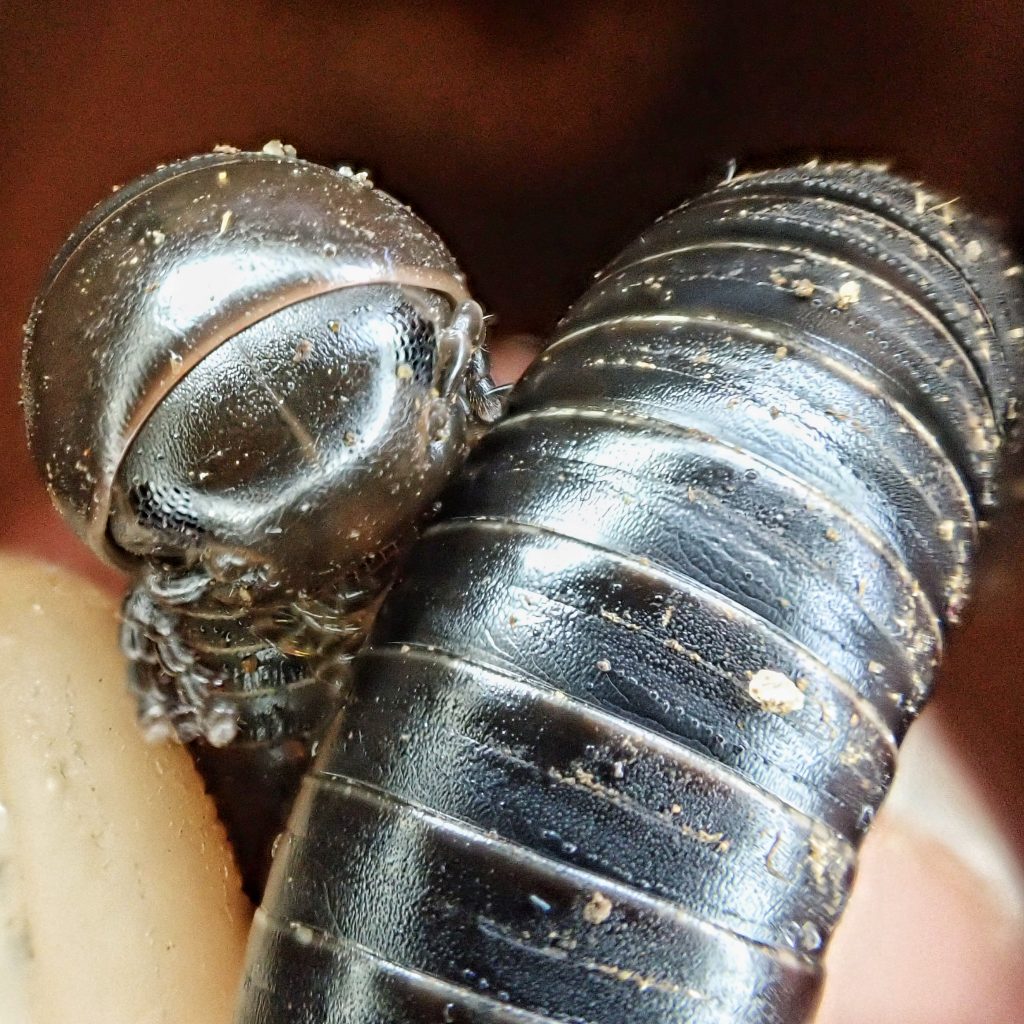
Though they share a subphylum, centipedes are a completely different class (Chilopoda) than millipedes, and despite similarity of form and multiplicity of legs, they are no more alike than bipedal humans and bipedal ostriches, although both bipeds are members of the subphylum Vertebrata (which is not to say that some humans don’t figuratively bury their head in the sand, although ostriches in fact do not do so; that is just a myth. But I digress). The simplest way to distinguish millipedes from centipedes is that millipedes have 2 pairs of legs per body segment (although the first segment is legless, and then there are three single pairs of legs wherein it is not clear to what segment they belong, and one posterior segment that has only one pair), whereas centipedes only have one pair per segment.
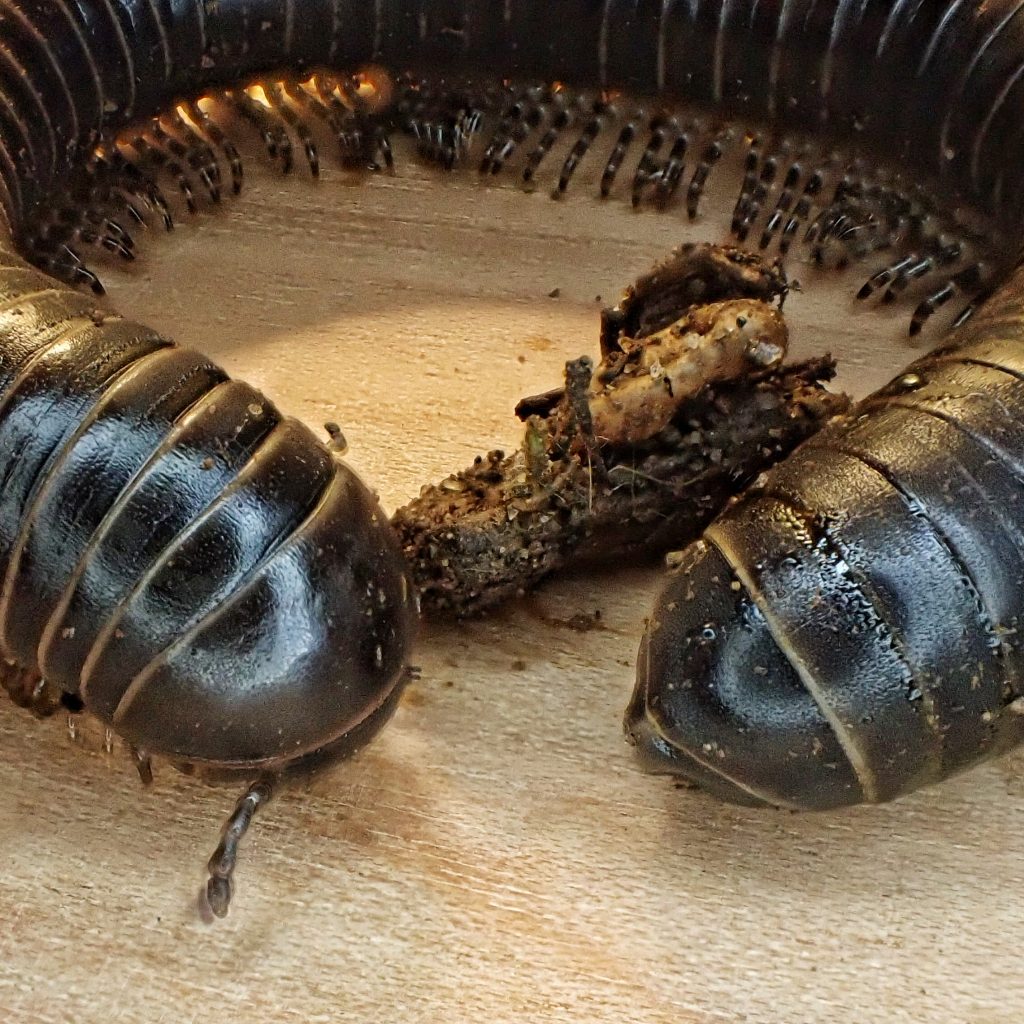
Behaviorally one of the primary differences is that the vast majority of millipedes are herbivores or detritivores, while virtually all centipedes are carnivores, which is why most centipedes have the two front legs modified into venom injectors called forcipules, while millipedes lack any such accoutrements. Many millipedes do produce defense chemicals, including cyanide, but Tylobolus uncigerus and many other Spirobolidae manufacture (in the repugnatorial glands on each segment) benzoquinones and hydroquinones which are not nearly as toxic but do produce skin irritation and staining, and are acrid to taste and foul smelling.
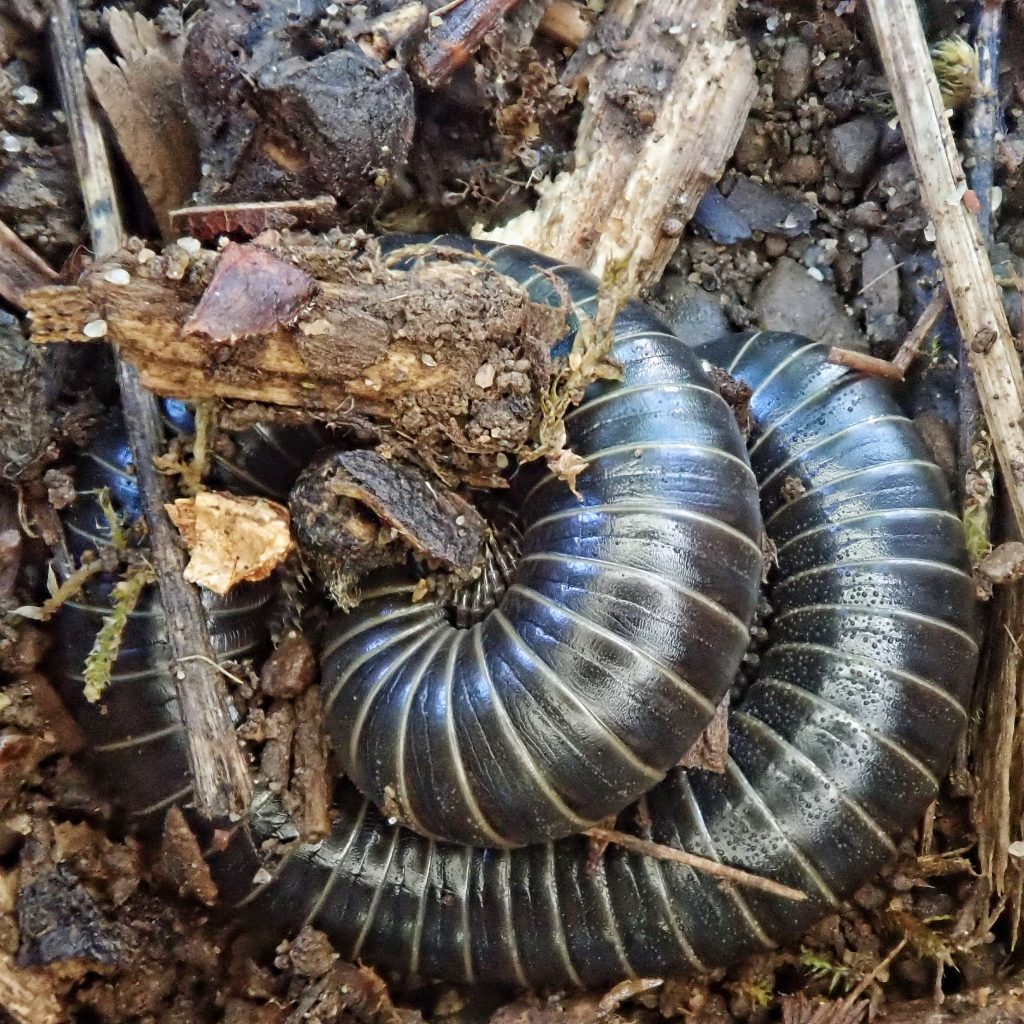
Much of the life history for this species is unknown. In fact the only information I did find for anything in the family Spirobolidae is for the genus Narceus, which are larger millipedes that are found in eastern North America. The broad outline is probably similar, though fine details are doubtlessly not the same. They are nocturnal animals that spend most of their life under logs, rocks, leaves, bark, and other suitable cover (since Tylobolus are lacking a waxy cuticle over their exoskeleton, these millipedes are prone to desiccation and therefore seek humid environments), but can most easily be found crawling about in the open during the warm, humid nights of summer. During these periods they consume prodigious amounts of humus, rotting leaves, and decaying wood, providing an important intermediary step in the decomposition of dead plant matter.
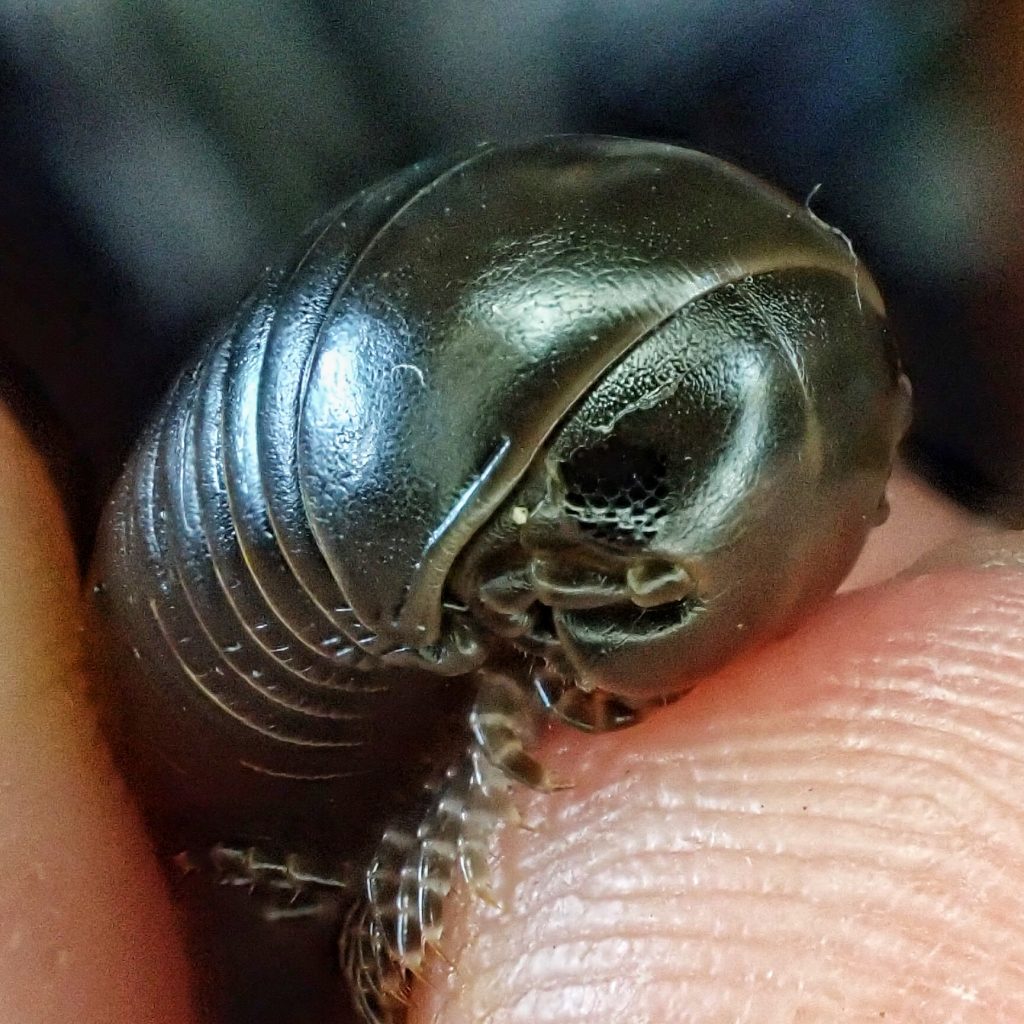
Reproduction is a complicated affair (as it is with most arthropods), and occurs in spring and early summer. Males must transfer a sperm from the anterior gonopores to the posterior gonopods for delivery into the female’s reproductive organs. They then broadcast pheromones by which the females can find them. Courtship often involves the male walking atop the back of the female. Females may lay dozens to hundreds of eggs, but they wrap each fertilized egg in a pellet made of fecal material, and place them in humid environments under leaves and bark. In about 12-14 days the egg hatches into a small grub, whose only features are a pair of eyespots . After the first moult they have developed a distinct head, 5 segments, and 3 pairs of legs. After the next moult they have at least 20 segments, 7 pairs of legs, and 3 eyes in each eyepatch (eyepatches in Diploda are congregations of simple eyes in the integument, rather than protruding collections of compound eyes, and vary in number from 1-50 in T. uncigerus, depending on age, and even from one side to the other). Thus far they have been feeding on the pellet encasing them, but during this stage they emerge to roam freely. It is unknown how many instars are required to reach maturity, but it is probably at least 10, which may take up to two years. At sexual maturity Tylobolus uncigerus has at least 46 segments and 89 pairs of legs. No millipedes actually have 1,000 legs, although Illacme plenipes from central California comes closest, with 750 legs. Female Tylobolus may continue to grow (moult) after mating (although the males die soon after) and Tylobolus uncigerus have been found with up to 54 segments.
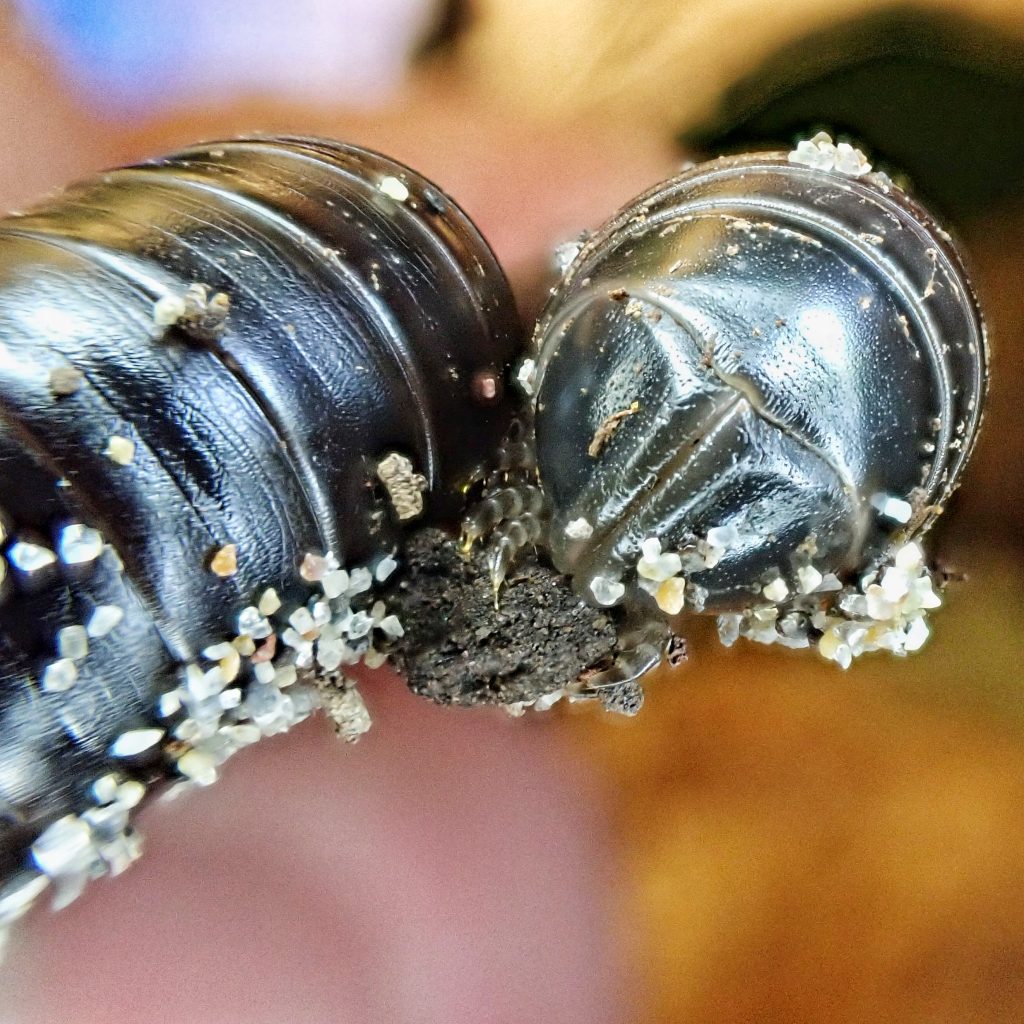
This has been a frustrating and time consuming profile to write, both because of a dearth of information on this species, and a lack of access to that information. If any of you good readers can point me to more information on the natural history of Tylobolus in general,or Tylobolus uncigerus in particular, I would be grateful. One thing that was actually very easy was the identification. Not so much because it is the largest millipede in our region, since relative size isn’t always an objective criteria, but because the suture in the center of the frons (the front surface of the head) extends all of the way to the labrum, which is diagnostic for the whole order Spirobolida, and Tylobolus uncigerus, which has the most northerly distribution of anything in Tylobolus, is the only Spirobolid in our region.
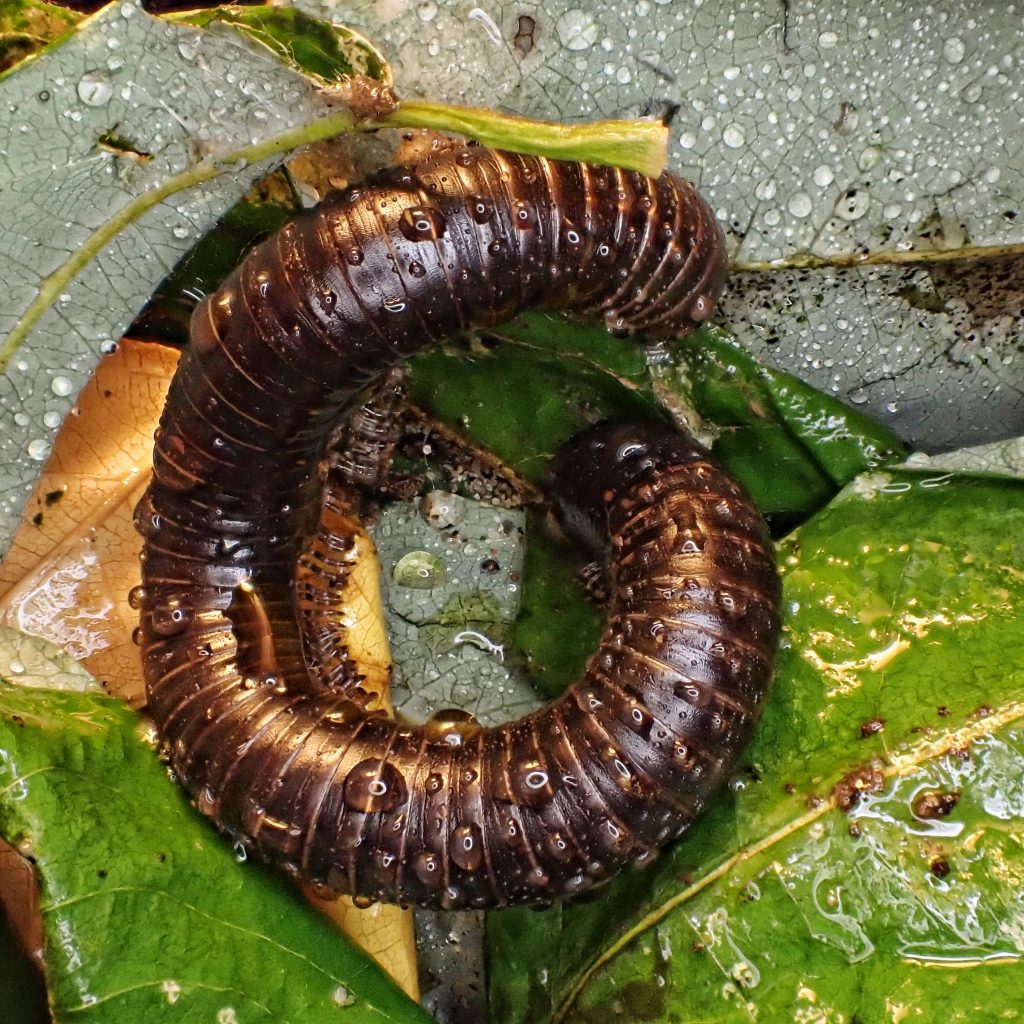
Description-Large (width 5-8mm, length 52-86mm), greyish brown (sometimes greenish in southern populations), cylindrical millipede; lighter brown on rear margin of each segment; has a suture in the center of the frons (forehead beteen the eyes); striations, if present, are only on the lower portion of the dorsal segment.
Similar species–Califoriulus spp. are the only other millipedes this large in our region, but they are more slender and have a light colored band down the length of the body; Some members of Bollmaniulus and Litiulus could be mistaken for immature Tylobolus but they are narrower and are often patterned; certain introduced millipedes in Julidae may seem superficially similar, but they have striations on the entire segment; suture (groove) in middle of the frons that extends to the labrum is diagnostic for the order Spirobolida, and Tylobolus uncigerus is the only member of that order in our region.
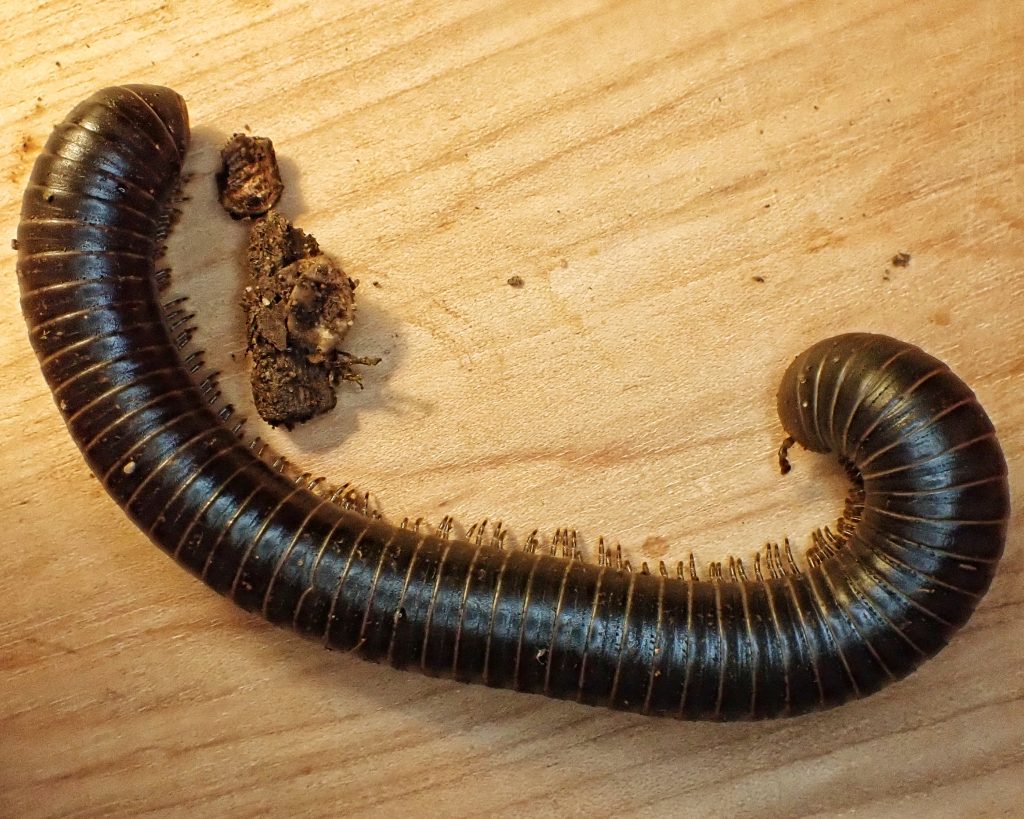
Habitat– Moist to mesic forests and woodlands; usually under logs, rocks, leaf litter, and in other high humidity locations.
Range-West of the Cascades from sw Washington south through Oregon; also found in n California.
Eats-Rotting leaves, humus, and other decaying organic matter; may also eat its own feces, although that is to replenish gut bacteria rather than for extracting more nutrition.
Eaten by-Presumably preyed upon by insectivores of many classes, though I can find nothing specific for this species; vertebrate predators will often ‘wipe off’ the millipede to get rid of repugnant chemicals.
Adults active-Nocturnal; year around but often retreat underground in the driest and coldest periods.
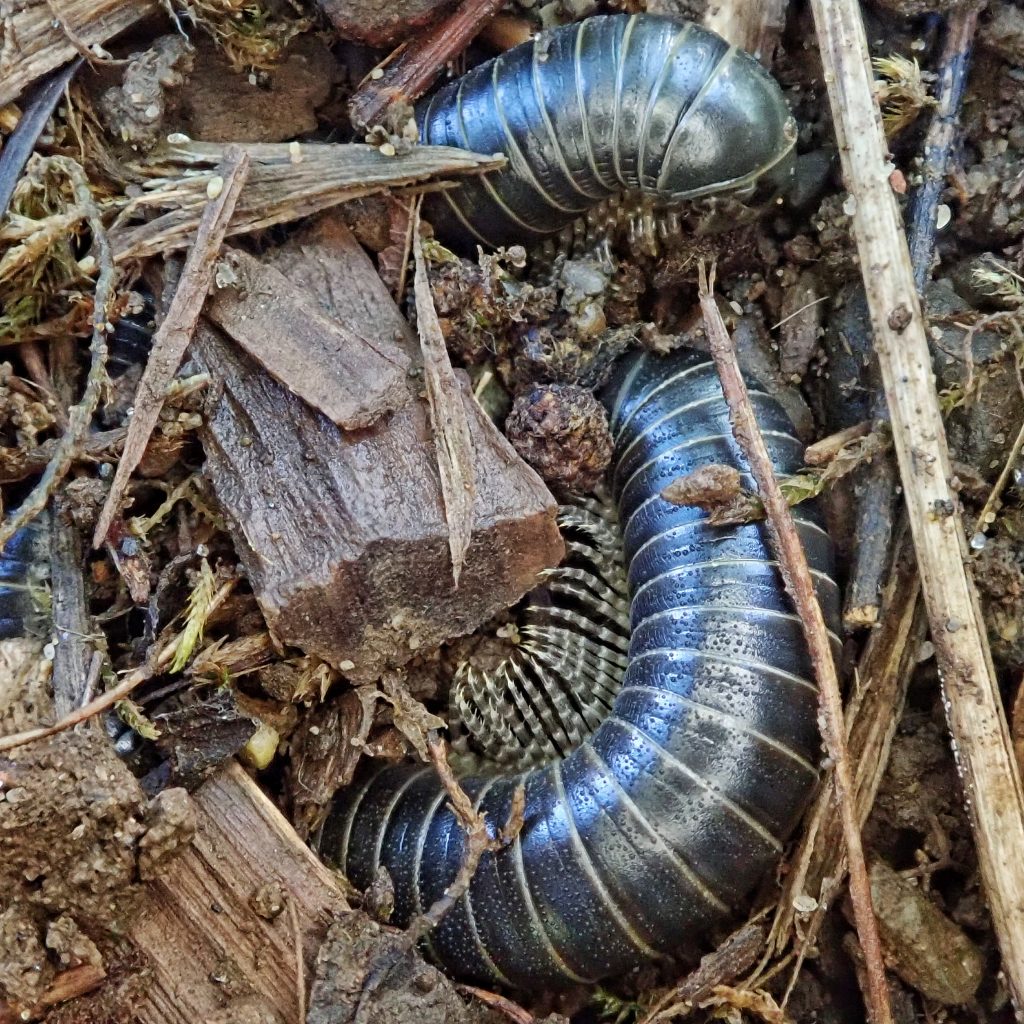
Life cycle-Females encase each egg in a pellet of fecal material and deposit them under cover; segments, legs, and eyes are added at each moult, and there are probably at least 10 instars until reproductive maturity, which may take up to 2 years; lifespan may be 7-10 years.
Etymology of names–Tylobolus may be from the Greek words for ‘knobbed lobes’, and possibly refers to the anterior gonopods having ‘lobes blunt, tubercular on the anterior face mesad’ (Cook; 1864), but Sam McNally disagrees with this interpretation because -bolus, meaning clod/lump in Greek, is a common suffix for taxa in this order, which would invalidate my idea of it referring to lobes. Unfortunately Cook doesn’t say for sure so we are left to guess. The specific epithet uncigerus is Latin for ‘having hooks’ and probably refers to hooks on the posterior gonopods.
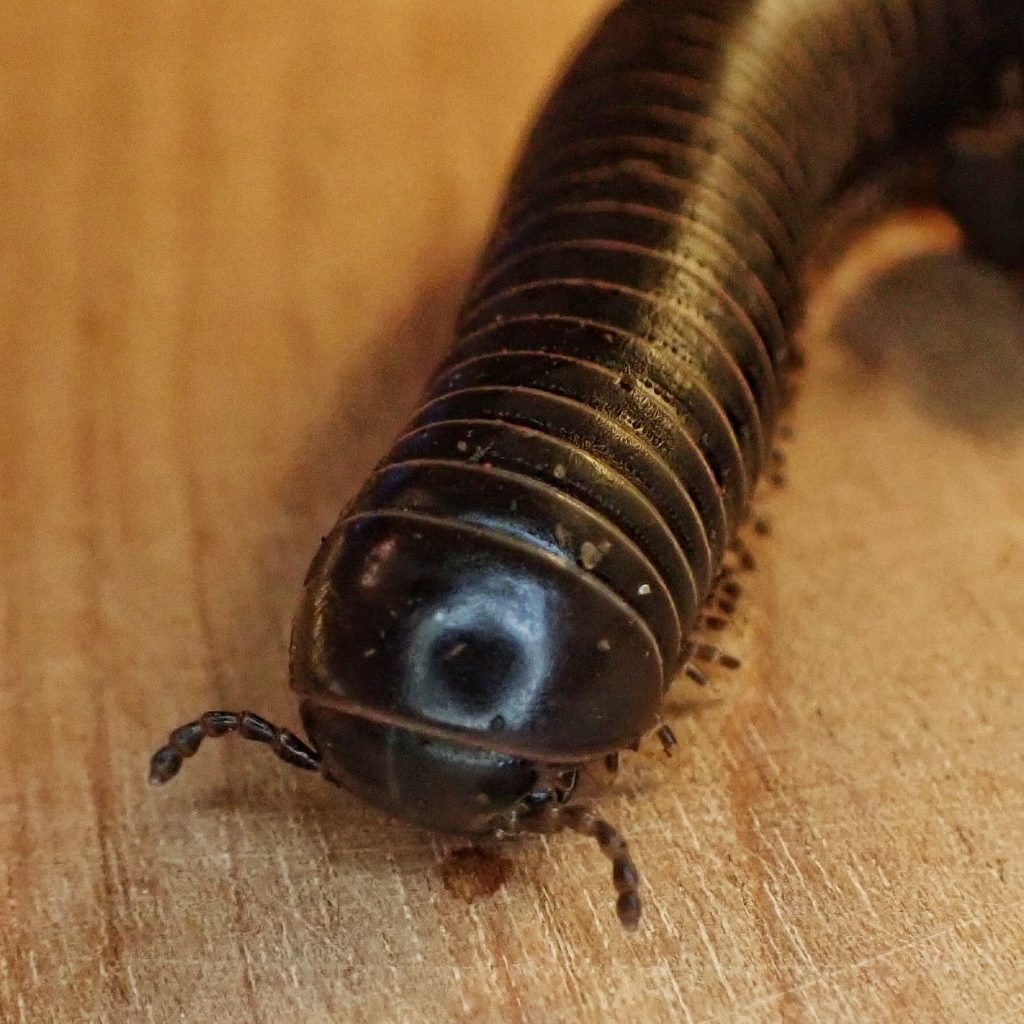
https://bugguide.net/node/view/865098
2-methyl-1,4-benzoquinone, 2-methyl-3-methoxy-1.4… – Google Scholar
ADW: Narceus americanus: INFORMATION
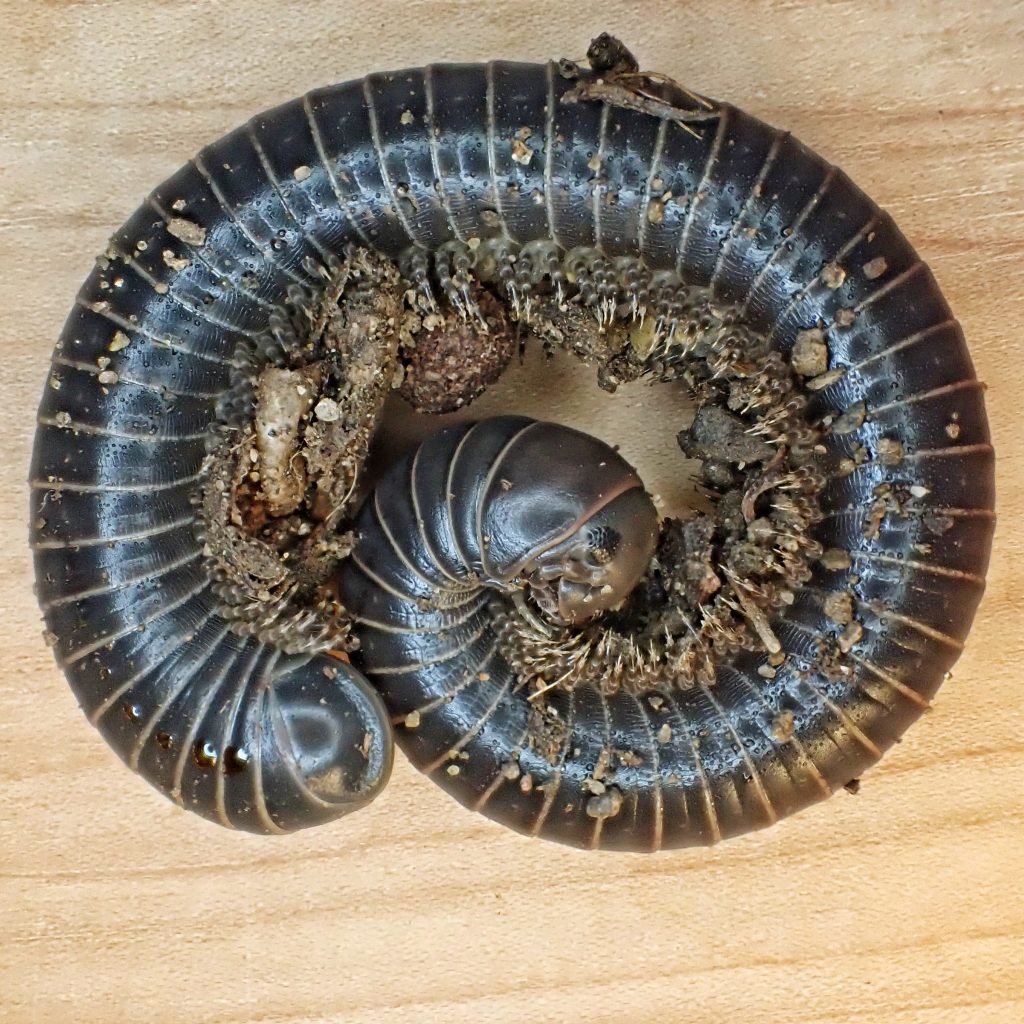
Thank you for such a detailed article, especially since it is hard to find info on this species! I have some Tylobolus unicergus as pets here that I wild caught in Marin County. Do you know if they tend to molt above ground at all? I also am raising some babies that are potentially a hybrid of T. unicergus and T. castaneus.
That’s very cool! I’m sorry, but everything I could find out about that species went into the profile, and I don’t remember seeing anything about the location of their moult. Good luck with your pets!
Hi again! I’m sorry I never saw your reply until now… I guess I didn’t get a notification! I’m still raising T. unicergus, and I might have some specific info to add, although it may only be specific to my region (N. CA). It’s also anecdotal, since it’s really just a few of my observations. Turns out they do burrow in the ground for months at a time! Mine disappeared into the soil around March/April, and just now came back up this week or so. I’m assuming because the species likes a damp environment, and it gets very hot and dry here in the summer, that they burrow from April to late November. I’ve confirmed this via sightings on iNaturalist for my area. There are many records from November to April or May, then no records from May through October (most of November too). I hope this info helps a little bit.
Most of my babies died 😭 due to dry conditions, but I still have 1 or 2 around. Most of my adult Tylobolus have also passed away, save one T. unicergus. I’m hoping they live for a long while longer, and that I can find some friends for them soon! Thanks again for all the great info!
That is great information, Jenny! Thanks for sharing that with us! I hope you clicked on the box to recieve follow up comments. I always try to respond to anyone who takes the time to leave a comment.
Jenny, how are you keeping them? I was thinking of collecting some that wander into my office. I would use a 10gal terrarium with a base layer of gravel, add some ground up dry leaves and small twigs, soil, and then some loose mulch with rock and wood hardscape. Is that similar to your habitat? If not, could you explain what method yo tried?
I acquired a female T. uncigerus with offspring in November 2017, she is still alive and molts once a year. Males matured two years ago (maturity confirmed by mating and offspring) and continue to live currently. Early 2000s I had a male T. utahensis which lived three years and molted annually (adult molts of this genus rarely include “growth” in terms of increase in size). Tylobolus males do not normally die after mating.
That’s very interesting, Orin! Thanks for sharing that with us. Have you shared this with millipede researchers, or written about it yourself?